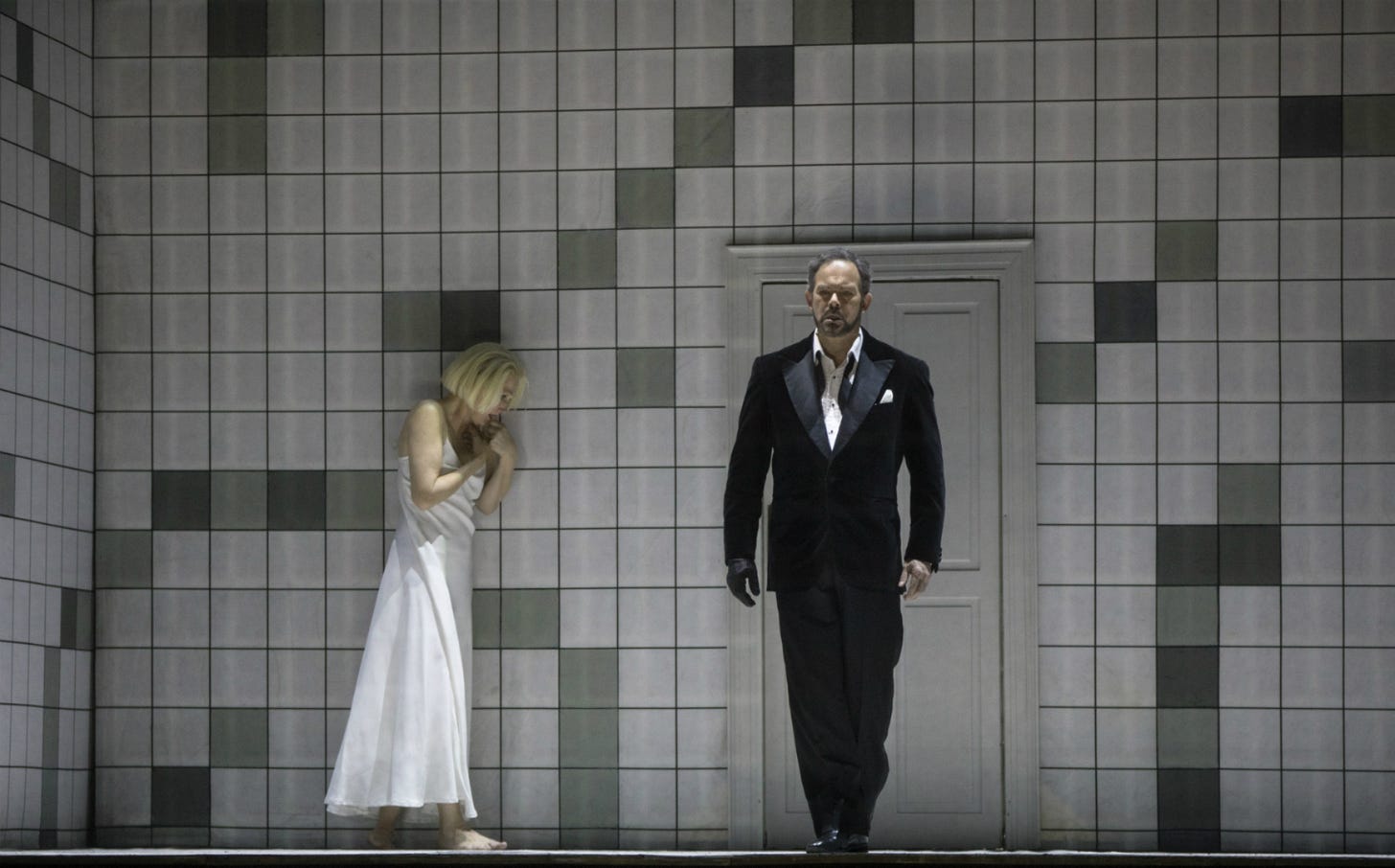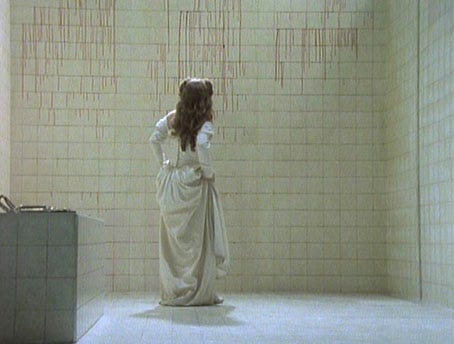Is There Such Thing as A Horror Opera? Bluebeard's Castle, Béla Bartók
Horror Moments, Opera Edition
‘Horror Moments’ is a weekly series examining horror-inflected scenes and themes in unexpected places. The ‘moments’ are published weekly on Thursdays, and I share articles on the history of magic, theatre, storytelling, and more on Mondays. Catch up with the recent Kate Bush series here and the full back catalogue of horror moments (from Wallace & Gromit to Shakespeare) here. Don’t forget to subscribe!
‘There was an old castle, so old that even the legend about it is lost in time. Listen to the song. Listen, and take care…’
Spoken prologue, Duke Bluebeard’s Castle.
Opera and horror are supposedly both acquired tastes, opera because it is highbrow, difficult, and elitist, horror because it is lowbrow, trashy, and grotesque. In reality, a lot of the plots of operas read like Penny Dreadfuls and ghastly scenes are par for the course: the two genres have far more in common that you might expect.

Are there ‘horror operas’ in a more total sense i.e. operas that don’t just contain violence and death but which are firmly planted in the horror genre because of their mood, style, story and more?
At first glance the answer is a resounding ‘no.’ There are lots of things about the form that make it difficult to create the kind of tension usually required for scary storytelling. I don’t know if you realised this, but in opera everyone is constantly singing, and when you’re singing you take a lot longer to say things. Great horror lines would become comically distended, imagine: “weeeeeee’re gonnaaaaaa neeeeeeeeeed a biiiiiiiiigeeerrrrr” *takes breath* “Boo-OAAAAAAAAAAAAAAAAAAAAAAaAAAAATTT!!!” Things like jump scares would be near impossible, and opera shares with theatre the difficulty of not being able to control an audience’s eye making it particularly challenging to compose with light and shadow, the seen and unseen. It would be hard to adapt most horror films for opera – although that hasn’t stopped some composers from trying, as we’ll discover.
So here begins my brand new series of horror moments. It’s been lots of fun to research and we’ll be venturing through some truly extraordinary and obscure pieces of art that I had never heard of before. From haunted lighthouses to fabled serial killers, cursed toys to a man pretending to be a dog in a dystopian hellscape, this series of articles will explore ten times when opera and horror went hand in hand.
And to begin our journey this week, we come knocking on the door of a fairy-tale castle. It is a castle full of locked doors which will be opened one by one. You know exactly what’s waiting for you in that final bloody chamber, but oh what sights we have to show you on the way!

Duke Bluebeard’s Castle was composed by Béla Bartók and premiered in 1918. It’s in Hungarian (A kékszakállú herceg vára) and it’s only about an hour long so it’s worth watching with subtitles if you don’t want me to spoil it by telling you roughly what happens
The librettist (the person who writes the words) was Béla Balázs and it’s based on the fairy tale as told by Charles Perrault.
Because it’s a one-act opera, the story doesn’t need to be much more complicated than the fairy tale and there are only two characters. There’s Judith, sung by a soprano or mezzo-soprano, the new young wife who seems to have forsaken her family and run away with Bluebeard. She’s a fascinating figure, both vulnerable in the castle and strangely commanding as she makes demands of her new husband. She shares the audience’s curiosity and, like us, is both appalled and fascinated by the strange sights that are slowly revealed behind seven locked doors. The opera is literally just the process of opening these doors and discovering what lies behind each one.
Bluebeard himself is a bass or bass-baritone, an older man with a deeper voice. He’s got to be sexy, I think, or Judith’s character doesn’t make sense. Balázs complained that in the first disastrous production Bluebeard came off as comical which ruined the effect. He’s strong and stern, older than her and a much stiller and more restrained figure. On the surface at least, he is traditionally masculine and she traditionally feminine, but like all human beings, both are in fact a mixture of the two. Judith is oddly thrilled, even a bit turned on by the sight of the torture chamber behind the first door, and then by the weapon hoard behind the second. She seems to be delighting in the power she wields vicariously through her new husband. As he shows her the chambers he tells her each time that their contents belongs to her and she accepts it all.
He, meanwhile, becomes more vulnerable and nuanced as we find out more and more about him. Doors now open to reveal beautiful gardens, although the plants bleed when they are plucked. Everything in the castle drips blood on closer inspection; Judith notices that the very walls seem to weep with it.
It’s clear that Bluebeard’s Castle is Bluebeard himself, and she is unlocking ever more private chambers of his psyche until —
Well what does she find at the end of her journey? Having grown closer to him than she has ever been before, having let light into all the locked rooms in the castle, having made love to him through the night, having almost figured out his puzzle, she begs him for the final key. Finally, he gives in and she opens it.
The seventh chamber reveals the figures of his three former wives, existing in a state between life and death. One for the morning, one for noon, one for the afternoon and now — one for the night time. The last of his victims, Judith knows there is no point in running away. Perhaps she always knew this was her destiny. She takes her place in the display, dead or transfixed, in his most secret chamber.
And so the opera ends. What exactly did it all mean?
Oddly enough, it is Judith whose character changes the most in different interpretations of the piece. Depending on your point of view she is either a truth-seeker compelled to unearth hidden horrors and expose a tyrant, or she is a prying and invasive manipulator, an abuser even, who forces her way into the most private inner sanctum of another person to their mutual destruction. That analysis is ironic given that the original fairy tale likely had its origins in women’s swapped stories of abusive husbands, their fear of the men to whom they were married, of vanishing forever behind unfamiliar walls. Angela Carter’s The Bloody Chamber (1979) famously reimagined the story as one of feminist resistance, complete with an angry and avenging mum. I think Bartók’s version is one of very few where the ending feels somehow like a tragedy for both characters: no one really wins.

So is it a horror opera? There are a few other features that give weight to that description. In the stage directions, spirits cry and sigh and a director can play up or down the ghostly presences forbidding Judith to take another step. There’s opportunity here for gothic grandeur of a kind that would suit Dracula, all looming walls and shadows with rich red gore ever-seeping through the cracks.
There’s a moment in this 1988 film adaptation of when Judith opens the first door and describes the torture chamber. She sings the original lyrics, telling us that she sees chains and daggers ‘red hot irons…spiked weapons’ but what we see is an empty room, tiled white and bare (besides the blood of course) it looks suddenly very modern, like a room in an asylum. It has a table which seems prepped for human medical experiments. I saw a room just like it in a concentration camp once on a school history trip. When Judith comes out she is wearing a red sash, stained by the experience. Leslie Megahey, the director, was evidently interested in layering modern horrors over the original text. He had also adapted the work of gothic ghost story writer Sheridan Le Fanu.
How appropriate that we begin this series with a story all about the dangers of wanting to know too much! Why are we, like Judith, so drawn to peek into forbidden places?
‘Why do you want this?’ Bluebeard asks as she begs for the next key
‘Because I love you.’ she replies.
Next week we’ll unlock another door as we turn from the horror of abstracted psychological spaces to very real and grimy streets where horrid crimes based on true murders will unfold.
Until then, happy nightmares everyone!
Horror moments are posted every Thursday and a wide variety of articles exploring the history of magic, theatre, storytelling, and more are published on Mondays.
Annual subscriptions are half price this week to celebrate me reaching my latest subscriber milestone. You can also buy me a coffee here to keep me writing, or like, share, comment, and recommend to help the substack grow. Thank you!









One of my favorites was the operatic adaptation of Henry James “The Turn of the Screw”: The Innocents. Even within an entire auditorium of patrons the hair stood up on the back of my neck as the malevolent spirits from the lake observe the innocents.
That would be Der Ring des Nibelungen in a single continuous performance ;)
Old joke, I know.